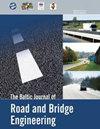基于离散元法的沥青混合料蠕变特性研究
IF 1.1
4区 工程技术
Q4 ENGINEERING, CIVIL
引用次数: 6
摘要
通过单轴压缩蠕变试验,建立了基于三维细观结构的离散元模型,研究了高粘弹性沥青砂(HVAS)的蠕变特性。通过沥青砂浆三点弯曲蠕变试验,获得Burger模型参数,在理论上确定模型宏观参数与微观参数的转换方法,得到离散元模型中使用的参数,进而建立沥青混合料的离散元分析模型。3D-DE数字试件由粗集料、沥青砂浆和空隙组成,同时考虑了集料的级配、不规则形状、随机分布和空隙,并通过模拟单轴压缩蠕变试验设置了模型的边界条件。利用3D-PFC (Particle Flow Code)软件建立了精确、广泛的HVAS映射模型,为实验室测试提供了一种简单的替代方案。该方法可以单因素模拟基于不同应力水平、粗骨料均质化、砂浆均质化和温度的一系列数值算例。室内试验结果与数值试验结果的对比表明,3d - pfc粘弹性模型能较准确地反映沥青混合料的蠕变力学行为。为应用PFC软件分析沥青混合料的力学性能提供了理论依据和辅助手段。通过数值模拟研究沥青混合料的蠕变特性,为沥青混合料的蠕变特性研究开辟了一条新的途径,具有相当的理论价值和广阔的应用前景。本文章由计算机程序翻译,如有差异,请以英文原文为准。
Study on Creep Behavior Of Asphalt Mixture Based on Discrete Element Method
A three-dimensional (3D) microstructure-based discrete element (DE) model was developed to study the creep behaviour of high viscoelastic asphalt sand (HVAS) with the uniaxial compression creep tests. The three-point bending creep tests of asphalt mortar were carried out in order to obtain the parameters of the Burger model, to determine the transformation method of macroscopic parameters and microscopic parameters of the model in theory, to obtain the parameters used in the discrete element model, and then establish the discrete element analysis model for the asphalt mixture. A 3D-DE digital specimen was composed of coarse aggregates, asphalt mortar and air voids, which could also take gradation, irregular shape, random distribution of aggregate and air voids into consideration, and the boundary conditions of the model were set through the simulation of the uniaxial compression creep tests. An accurate and extensive mapping model of HVAS was built by 3D-PFC (Particle Flow Code), which can provide a simple alternative to the laboratory tests. This method can simulate a series of numerical examples based on different stress levels, coarse aggregate homogenizations, mortar homogenizations and temperatures in a single factor method. Comparison of results of laboratory and numerical tests shows that the 3D-PFC-viscoelastic model can reflect the creep mechanical behaviour of asphalt mixture accurately. It provides the theoretical basis and auxiliary means for analysing the mechanical properties of asphalt mixtures using PFC software. The research on creep behaviour of the asphalt mixture by numerical simulation opens up a new way for the research on creep behaviour of the asphalt mixture, it is of considerable theoretical value and has broad application prospects.
求助全文
通过发布文献求助,成功后即可免费获取论文全文。
去求助
来源期刊
CiteScore
2.10
自引率
9.10%
发文量
25
审稿时长
>12 weeks
期刊介绍:
THE JOURNAL IS DESIGNED FOR PUBLISHING PAPERS CONCERNING THE FOLLOWING AREAS OF RESEARCH:
road and bridge research and design,
road construction materials and technologies,
bridge construction materials and technologies,
road and bridge repair,
road and bridge maintenance,
traffic safety,
road and bridge information technologies,
environmental issues,
road climatology,
low-volume roads,
normative documentation,
quality management and assurance,
road infrastructure and its assessment,
asset management,
road and bridge construction financing,
specialist pre-service and in-service training;

 求助内容:
求助内容: 应助结果提醒方式:
应助结果提醒方式:


